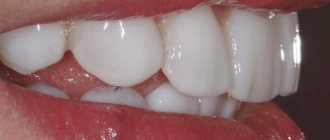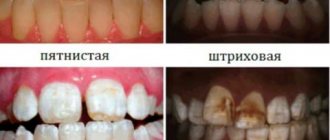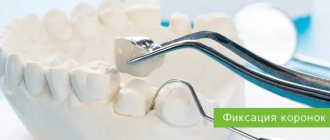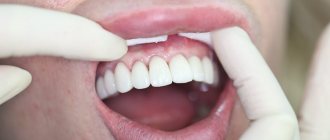Why is the enamel grinding procedure carried out?
Grinding of teeth involves removing a layer of hard tissue (enamel and dentin), so that the orthopedic structure subsequently installed on the “support” looks natural and beautiful, fits tightly, is securely fixed, has stability and strength. This is also done to ensure that microbes do not get under the prosthesis or food debris gets clogged, which together can provoke the development of an inflammatory process.
On a note! Typically, the doctor removes a layer equal to the thickness of the chosen prosthesis. If a crown or bridge is installed, the tooth is ground down to a cone shape. When turning for microprostheses, for example, for veneers, the specialist “cuts down” the enamel in the frontal, lateral and cervical areas.
Often after the procedure, the patient’s gums around the ground tooth hurt, or the prepared element itself ache. Naturally, discomfort does not arise immediately, but after the anesthesia wears off. For some people, discomfort does not appear until several days, weeks or even months later. What is this connected with? We'll figure it out together.
How to treat a tooth under a crown
Treating prosthetic teeth is difficult and expensive. Inflammation can only be relieved by eliminating its cause. To do this, you need to unseal the canals, carry out anti-inflammatory therapy, which can last 2-3 months, then fill the canals again.
The patient will not only have to endure several unpleasant procedures, but also pay for a new prosthesis, since in most cases the crown has to be removed. Sometimes the doctor manages to refill the canals without removing the prosthesis. A hole is drilled in the crown, which is closed with a filling after treatment. But this is not always possible.
Not all specialists agree to treat a tooth under a crown. This is very labor-intensive work and there is no 100% guarantee that refilling will save the tooth. Many doctors in such situations immediately refer the patient for removal. Our clinic’s specialists take on even the most difficult cases and use every opportunity to save patients’ teeth.
If inflammation occurs due to underfilling of the canal, but it is impossible to treat with conservative methods, the doctor may suggest that the patient solve the problem surgically - perform resection (cutting off) of the root apex. In this case, the unfilled area, together with the granuloma or cyst formed on it, is removed through an incision in the gum area. The operation is performed under local anesthesia and lasts from 30 to 60 minutes.
The doctor determines the method of treatment in each situation individually, based on the cause and stage of the inflammatory process. Unfortunately, there are situations when it is truly impossible to save a tooth and the only option is extraction and subsequent prosthetics.
Causes of painful sensations in teeth
1. Physiological response to intervention
This is the most common reason why teeth and gums hurt after grinding for crowns and other orthopedic structures. After all, during the procedure, the specialist acts on the tissue instrumentally and medicinally, touching the nerve endings. This reaction is considered normal.
On a note! If, after grinding teeth, hyperesthesia (increased sensitivity) and aching pain appear, especially during the consumption of cold, hot, sour and spicy foods, and hygienic cleaning, then this often simply indicates a thinning of the tissue area of the prepared unit.
Most often, hyperesthesia after turning occurs on vital, that is, living units where the pulp is preserved. Sensitivity is enhanced even despite the presence of temporary crowns, which, it would seem, serve as reliable protection from external irritants. Temporary structures are fixed immediately after preparation and worn until permanent dentures are created.
Medical errors
If a tooth or gum hurts after grinding, then unqualified actions by the doctor cannot be ruled out. Most often, inexperienced specialists make the following mistakes:
- overheating of the pulp: occurs when preparing tissue with a bur,
- removing too much tissue,
- nerve injury: to avoid complications associated with damage, overheating or inflammation of the nerve under the prosthesis, experienced specialists advise depulping the tooth, that is, first removing the pulp from it.
If the doctor made the mistakes listed above, then the pain makes itself felt almost immediately after the procedure and can persist for several weeks or even months.
3. Development of a pathological inflammatory process
If a lot of time has passed after medical manipulations, and you have severe discomfort and your teeth hurt after grinding for crowns and bridges, then this signals the development of various dental diseases: caries, pulpitis, periodontitis, cyst, granuloma, fistula, abscess, gumboil. In this case, the pain does not go away for a long time, intensifies with each subsequent day, and is poorly relieved by analgesics. Along the way, other alarming symptoms arise: purulent bumps appear on the gums, the gums and cheek swell, the body temperature rises, it becomes painful to chew and press on the causative element.
More often, the problem arises again due to the fault of a clinic specialist who, during the preparation and preparation of tissues before prosthetics, violated the rules of asepsis, did not fully treat (after all, dentures are often placed on teeth destroyed by deep caries and other dental diseases), poorly cleaned and poorly sealed the roots channels. Pulpitis can occur if, in the process of preparing the “support,” the doctor caused irreversible damage to the nerve.
Expert opinion
Andrey Rastislavovich Chernov
Specializations: Orthopedic dentist
Experience: 11+
“Treatment, grinding and prosthetics of a tooth with an orthopedic design is a complex and multi-stage process, in which at least several experienced specialists must take part - a therapist, a dental technician (creates a prosthesis using casts of the jaws), an orthopedic doctor. If everyone has done their job efficiently, then pain after completing all the manipulations should not arise either in the short or long term.”
Sometimes a pathological inflammatory process occurs due to the fault of a patient who systematically violates oral hygiene, does not monitor the condition of installed dentures and surrounding tissues, and receives various injuries.
A tooth hurts under a bridge: what to do?
If you experience pain under the crown, you should immediately go to the doctor. The doctor will prescribe treatment after a dental examination and x-ray examination. In most situations, the prosthesis will have to be removed, and then treatment with re-prosthetics will be carried out. If inflammation spreads deep into the tissue and there are complications, therapy will require several months.
How to remove pain under the crown of a tooth yourself?
Taking an analgesic, a non-steroidal drug, will help relieve pain temporarily. In dentistry, Ibuprofen, Dexalgin, Tempalgin, Ibuprom, Imet, Ketanov, Nalgesin, Nurofen, Ortofen, etc. are usually recommended. You need to take the tablets according to the instructions. Rinsing with herbal decoctions (sage, chamomile, oak bark, calendula), and a soda solution (1 teaspoon of soda per glass of warm water) every 2-3 hours will help relieve inflammation.
These remedies can only be used as an “ambulance” for pain. The painkiller simply masks the pain syndrome, while the inflammation spreads further. Sometimes it happens that a tooth causes discomfort only when there is a load, but there are no other unpleasant sensations. But even a sluggish pathological process is dangerous and requires treatment. Only a dentist can say for sure why the tooth under the crown hurts when biting.
It is strictly forbidden to heat the inflamed area, drink aspirin, or take antibiotics without a doctor’s prescription. Each of these situations can lead to serious consequences, including sepsis. Therefore, if a tooth under a crown hurts, you should immediately contact a dentist. Self-medication will do more harm than good.
When do you need urgent medical help?
- Acute pain, intensifying when biting or closing the jaws;
- redness, swelling of the gums in the projection of the root apex;
- purulent discharge from under the crown;
- pain in the gums when touched;
- the gums and cheek are swollen in the area of inflammation;
- there was a putrid odor from the mouth;
- A fistula has formed on the gum.
Why does my gum hurt?
Sometimes the teeth do not react at all, but the gums hurt after grinding. Let's list the reasons for this:
- physiological reaction to an anesthetic injection,
- gum retraction: in order to qualitatively fit the prosthesis to the soft tissues and eliminate discomfort during operation, as well as to create a highly accurate design that fully corresponds to all the anatomical features of the patient, before taking impressions, specialists widen the periodontal sulcus. For the procedure, special threads are most often used, which are inserted under the gum and lift it. Such manipulations lead to the fact that the gums then become slightly inflamed and swollen, and also hurt for several days,
- individual reaction of the patient and allergies to the medications used during the grinding process: in this case, the gums may itch and itch, a rash appears on them,
- traumatic gingivitis and periodontitis: if in the process the specialist damaged the gums, then the patient experiences persistent aching pain, swelling and bleeding of the mucous membrane. As a rule, it all starts with gingivitis, but if the disease is neglected, it is complicated by periodontitis.
What to do if a crown falls out
The crown sometimes flies off the tooth not only due to the complete destruction of the stump tissue. Sometimes the prosthesis comes off because it is poorly fixed to the cement: the material has collapsed or the adhesion to the crown material has been lost.
Often people do not attach importance to this, installing the crown in place on their own each time. However, such neglect is fraught with rotting of the tooth under the crown or accidental swallowing of the prosthesis. Therefore, you definitely need to contact the clinic to correct fixation deficiencies.
If the crown falls out along with the pin or stump, the conclusion is clear - the doctor did not properly strengthen the structure inside the tooth. Particular care must be taken to follow the technology when working with a stump insert: after it is placed in the root canals of the tooth, adjustment of the structure with a drill is possible only after 24 hours. This time is necessary for the cement to harden.
Inexperienced dentists often begin adjusting the inlay 10-15 minutes after installation. The cement breaks down before it has time to harden. Of course, soon the entire structure falls out into the oral cavity. If the crown is in satisfactory shape, a professional dentist can quickly return it to its place if you contact him without delay.
Methods of tissue trimming: after which procedures pain occurs more often
There are different ways to prepare tissue. According to experts, after grinding the teeth, some of them may actually experience aching pain. But other methods, on the contrary, are considered gentle, and therefore do not cause discomfort at any stage of treatment and prosthetics.
Using a diamond-tipped bur
The drill, despite the loud, annoying sound, is still popular among dentists, because with its help you can quickly and efficiently carry out work of any level of complexity and scale, and grind off any amount of tissue.
It is boron that is most often used for preparing tissue for crowns and bridges, and for turning teeth for veneers. During the process, the doctor uses the device at different speeds so that it does not cause overheating of the tissues and pulp; at the same time, a cooling liquid is supplied to the oral cavity. Despite all the safety measures, many patients note that it was after using boron that they experienced pain.
Via ultrasound
Situations where a tooth hurts after grinding performed using ultrasound are quite rare. The method is characterized by a more gentle effect, compared to boron[1], allows you to process fabrics carefully and without contact, and does not cause overheating. However, ultrasound can still cause discomfort and short-term increased sensitivity of hard tissues and gums in people with a low pain threshold and weakened enamel.
The method is used if you need to remove a small amount of tissue.
Laser method
Here, a laser is used for preparation, which, like ultrasound, acts in a targeted and non-contact manner. The method is considered one of the safest and most painless[2], suitable for people with sensitive gums and mucous membranes, and does not cause pain or discomfort. The laser not only carefully grinds the tissues, but also disinfects them, promotes rapid healing, and prevents bleeding.
Water-abrasive treatment
Suitable only in cases where a minimum amount of tissue needs to be removed. During the process, a specialist treats the enamel with a stream of water containing abrasive particles. After such grinding of teeth, aching pain and any discomfort are completely excluded.
On a note! Until recently, dentistry also used a chemical method, where tissues were first softened using chemicals and then removed with an instrument. However, today this method is recognized as traumatic and very dangerous for the nerve of the tooth.
Reasons for installing a crown
A crown is a kind of cap that is placed on a tooth, covering and protecting its tissue. Installed in three cases:
- If the natural crown of the tooth is destroyed by more than half and it is impossible to restore it with filling material or other restoration methods;
- To improve the aesthetics of the dentition - correct the shape of the tooth, hide visual flaws;
- When using prosthetics using a bridge. In this case, crowns are placed on the supporting teeth.
A crown can only be installed on a tooth with an intact root. If the upper part is significantly destroyed and the carious process has reached the pulp, before installing the crown, the tooth is depulped and the root canals are filled.
When installing a bridge, the supporting teeth are covered with dental crowns, even if they are not destroyed. If the tooth is relatively healthy, the dentin and pulp are not affected, crowns can be installed without depulpation.
Our clinic’s specialists do not recommend that patients install bridges, but offer alternative types of prosthetics if the supporting teeth are healthy. To place a crown, the doctor must prepare (grind) the tooth, that is, completely remove the enamel. Without a natural protective layer, even if covered with a crown, the tooth becomes vulnerable and gradually collapses. A bridge should only be placed on teeth that have “nothing to lose.”
How long does the discomfort last?
Many patients are interested in how long their teeth can hurt after grinding. Normally, the unpleasant sensations disappear after 3-7 days. This is the case if the preparation was carried out without removing the nerve, or immediately after depulpation.
According to many experts, long-depulped teeth that have been ground should not hurt at all. If discomfort occurs, it goes away after 1-2 days.
When tissues and nerves are overheated with boron, increased sensitivity can persist for several months. But in any case, pain that intensifies and does not go away for more than one week should be a reason for a visit to the dentist.
Causes of pain
Unpleasant sensations can arise for various reasons. Sometimes this is a common reaction after the procedure, because the tissues need time to heal and adapt to the new structure.
Usually the pain is aching in nature and lasts no more than 3 days. If the pain is acute, does not go away and even intensifies, or at first it was not there, but some time after installing the crown it appeared, you should consult a doctor. Perhaps inflammatory processes have begun, and it is no longer possible to do without medical help. Causes of toothache under a crown.
The process of installing a crown on a tooth is a team effort of three specialists: a dentist-therapist, an orthopedic dentist, and a dental technician. A mistake in one of them can lead to unpleasant sensations.
What measures to take at home
When your teeth and gums hurt after grinding, it is important to know what to do in this situation. Usually, to quickly eliminate the physiological reaction of tissues to intervention, doctors advise performing the following procedures:
- mouth rinse: you can use chlorhexidine solution, Rokotan. Decoctions of chamomile and sage, which have a calming, antiseptic and anti-inflammatory effect, are also suitable. Rinsing is carried out 2-3 times a day,
- applications: if the gums hurt, it is recommended to apply Solcoseryl ointment to it up to 3-5 times a day,
- taking painkillers from a home medicine cabinet,
- following a gentle diet: in order not to further irritate sensitive tissues, it is necessary to exclude solid, cold and hot foods from the diet. It is better to also give up sour, salty, spicy and sweet foods for a while,
- Carrying out oral hygiene as carefully as possible: if your gums and sharpened teeth hurt, then under no circumstances should you stop performing hygiene procedures. However, to minimize discomfort, you can temporarily switch to a brush with soft bristles and a paste with anti-inflammatory components (chamomile, propolis).
Why can a tooth hurt under a crown?
Toothache can occur for several reasons, most of which are associated with poor preparation of the tooth for the installation of a crown. First of all, these are errors when filling root canals after depulpation.
Causes of inflammation
Inflammation under the crown can cause:
- Insufficient filling of canals. If the canal is not filled with filling material to the top, the empty space is quickly populated by pathogenic microflora. Its waste products cause inflammation.
- Poor obturation (filling of canals). If the doctor was in a hurry or, due to inexperience, did not fill the canals tightly with filling material, bacteria will settle in the resulting pores, which will ultimately cause inflammation. Crown pain may occur months or years later.
- Perforation of the canal wall. Most often this happens when the doctor mechanically expands a canal with an uneven axis with a rasp. For example, in a curved or bent root. In order to properly seal the canals in such roots without breaking through the wall, a specialist needs extensive practical experience. The doctor may also damage the wall when installing the pin. If the hole is immediately closed with a special material, there will be no complications. But if the doctor simply fills the canal without closing the “gap,” problems may arise. The filling material is not completely biocompatible with the periodontium - the connective tissue surrounding the root. If, through the resulting hole, it extends beyond the canal, the periodontium becomes inflamed. A complication of the inflammatory process can be a cyst or granuloma.
- A fragment of an instrument in the canal cavity. Unfortunately, this is a common occurrence. The instrument may break due to improper use technique, and this will be the doctor’s fault. Or due to the physiological characteristics of the root. For example, if it is strongly curved and difficult to pass. In this case, the specialist is not to blame. The main problem in such situations is that it is often impossible to remove the tool fragment from the canal. But no matter why the foreign body ended up in the canal, it can cause inflammation, even if the canal is sealed.
- Pulp burn. This happens when a crown is installed on a living (non-pulpless) tooth. During turning, the specialist must strictly adhere to the protocol. In particular, use water cooling and prevent tissue overheating. If the doctor does not adhere to the protocol and is in a hurry, the dentin overheats from the friction of the bur and “burns” the neurovascular bundle hidden underneath it. As a result, the pulp becomes inflamed, the tooth reacts to cold and hot, and acute pain may occasionally occur, turning into aching pain.
- Poor quality crown installation. For example, the denture does not fit well; there is a gap between the crown and the tooth. Another possible mistake is that the ledge for seating the prosthesis is made too low; the crown puts pressure on the gum and causes inflammation. In this case, the patient may feel that when pressing, the tooth hurts under the crown.










